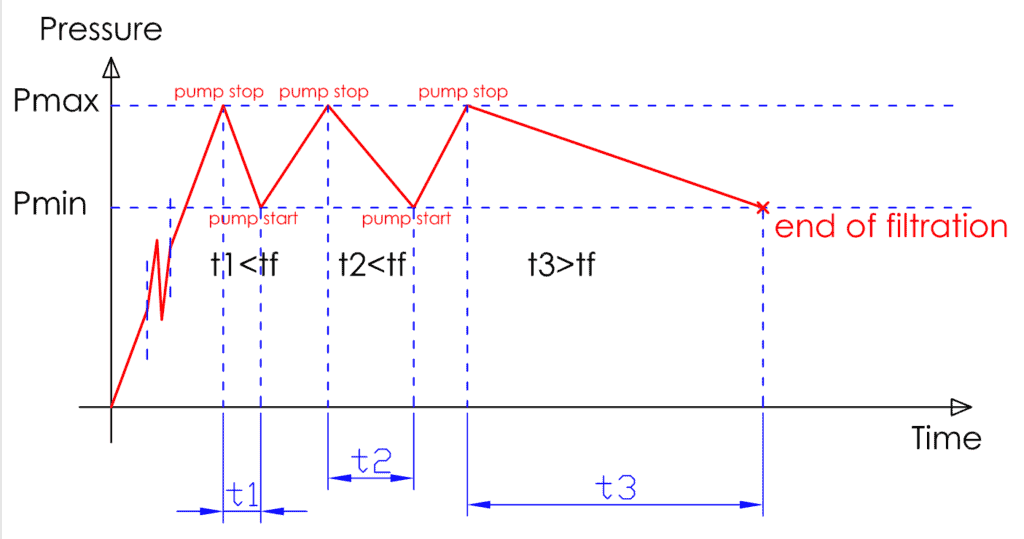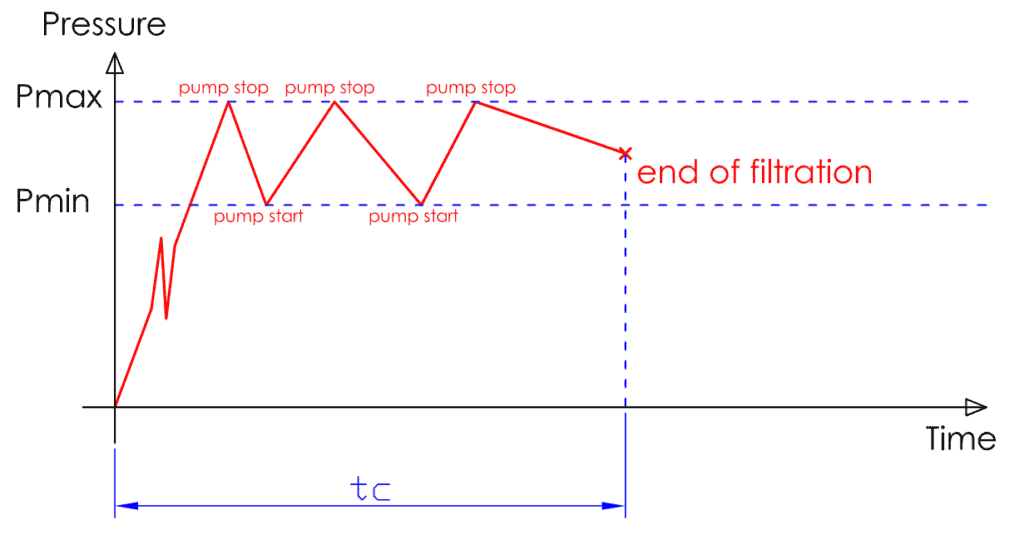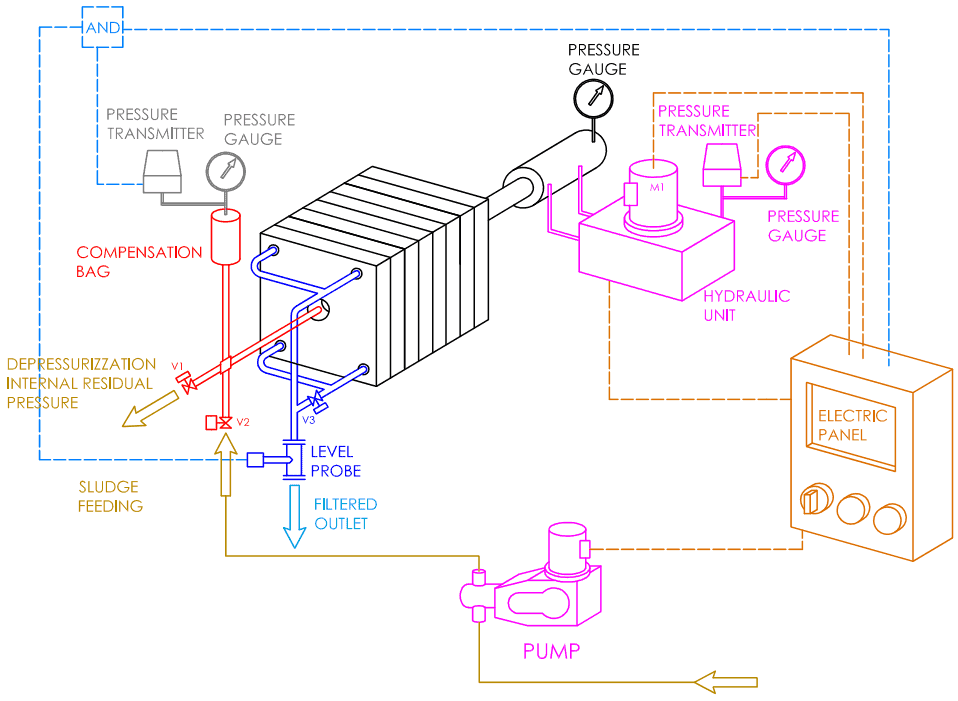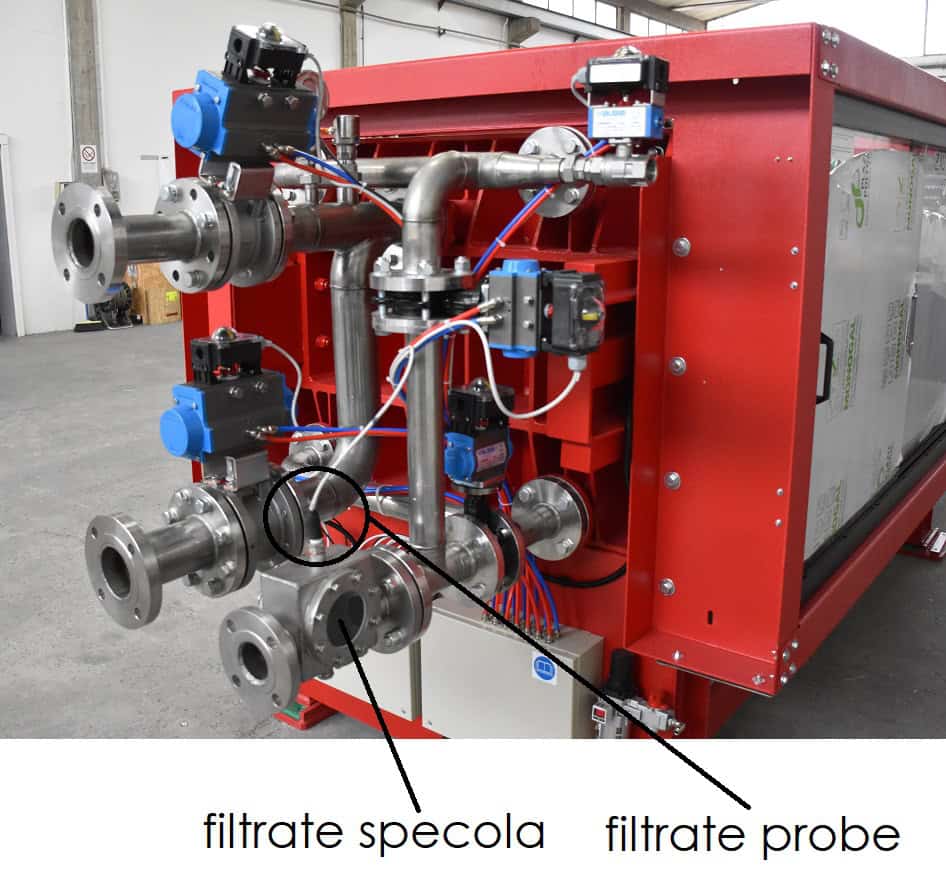Existen varios métodos para determinar cuándo puede terminar el ciclo de filtración y abrirse el filtro prensa y descargarse la torta residual.
En general, se trata de averiguar cuándo el filtro prensa está lleno o cuándo se ha alcanzado en su interior una presión tal que la torta está suficientemente seca.
There are several way to decide when the filtration cycle can end and it is possible to proceed with the opening of the filter press and the discharge of the residual cake.
Generally the aim is to understand when the filter press is full or when a pressure has been reached inside it such that the cake is sufficiently dry.
La primera medición que puede obtenerse claramente es una medición de la presión dentro del propio filtro prensa, a través de la lectura digital de un transductor de presión o presostato (en combinación con la lectura analógica del manómetro).
Una de las lógicas más utilizadas (sobre todo en máquinas pequeñas y medianas) es la lectura de la presión de alimentación de lodos: una vez alcanzada la presión máxima de filtración (Pmax) -que puede ser fijada por el PLC- se envía una señal a la bomba de lodos y al mismo tiempo se pone en marcha un temporizador.
Este temporizador mide el tiempo transcurrido entre el momento en que se alcanza la presión Pmax y el momento en que se alcanza la presión Pmin (también configurable desde el PLC). De hecho, cuando se detiene la bomba de lodos, la presión en el interior del filtro prensa desciende inevitablemente.
The first measurement that can easily be obtained is a pressure measurement inside the filter press itself.
We can have this value through the digital reading of a pressure transducer or a pressure switch (in combination with the analog reading of the pressure gauge).
One of the most used system (especially for medium-small machines) is to read the sludge feed pressure: once the maximum filtration pressure (Pmax – settable by PLC) is reached, the signal is sent to the sludge pump and a timer is started at the same time.
This timer measures the time between the reaching of the Pmax pressure and the reaching of the Pmin pressure (also settable by PLC). In fact, when the sludge pump is stopped, the pressure inside the filter press will inevitably drop down.

Si este tiempo es inferior a un tiempo de fin de filtración ‘tf’ (ajustable por el PLC), significa que el filtro prensa no está lleno y aún puede llenarse.
Cuando se alcanza la presión Pmin, la bomba de alimentación se vuelve a poner en marcha hasta que se alcanza de nuevo la presión Pmax.
La condición final de filtración se alcanzará entonces cuando el tiempo necesario para registrar una caída de presión por debajo de Pmin sea superior al valor de referencia tf.
De esta forma podemos parar definitivamente la bomba y abrir el filtro prensa.
Alternativamente, es posible fijar un tiempo de ciclo “tc” para la duración máxima de la filtración. Después de este tiempo preestablecido, independientemente del valor de presión dentro del filtro, la filtración se detiene. Esto se debe utilizar si, debido a los requisitos del sistema, la filtración no debe durar más de un cierto período de tiempo. Evidentemente, dentro del ciclo, los valores de parada y rearranque de la bomba están siempre subordinados a los dos umbrales Pmax y Pmin, pero la lógica para decidir si la filtración ha finalizado depende únicamente del tiempo transcurrido desde el inicio de la filtración.
If this time is less than an end filtration time “tf” (settable by PLC), then it means that the filter press is not full and it is still possible to fill it again.
When the pressure Pmin is reached, the feed pump will then be restarted until the pressure Pmax is reached again.
The end of filtration condition will therefore be reached when the time required to have a pressure decrease below the Pmin threshold will be greater than the reference value tf.
In this way we can definitely stop the pumps and open the filterpress.
Alternatively, it is possible to set a cycle time “tc” of maximum filtration duration. After this preset period of time, regardless of the pressure value inside the filter, filtration is stopped. This is to be used if, due to some kind of plant requirements, you want to make filtration last no more than a certain amount of time. Clearly, within the cycle, the stop and restart values of the pump are always subordinated to the two thresholds Pmax and Pmin, but the logic to decide if the filtration is finished depends only on the time that has passed since the beginning of the filtration.

Otro método utilizado para saber cuándo se puede terminar la filtración consiste en leer, además de la señal de presión, una segunda señal que indica el nivel del filtrado.
Para ello, se instala una mirilla visual con una sonda de nivel en la salida del filtrado.
Cuando el filtro prensa está lleno y, por tanto, ya no hay posibilidad de que el filtrado se escape, la sonda de nivel deja de estar inundada por el filtrado y, por tanto, envía una señal al PLC de la máquina.
La presencia de esta señal, además de la señal de presión procedente del transductor, es gestionada por la lógica del filtro prensa que decreta el fin de la filtración, detiene la bomba de alimentación y procede con todas las secuencias de descarga de la torta.
Another method used to understand when the filtration can be stopped is to read, in addition to the pressure signal, a second signal that tells me the level of filtrate discharge.
To do this, a sight glass with a level probe is installed in the filtrate discharge collector.
When the filter press is full and therefore there is no longer the possibility of filtrate other liquid, the level probe is no longer flooded by the filtrate and therefore sends a signal to the machine PLC.
The presence of this signal, in addition to the pressure signal arriving from the transducer, is managed by the logic of the filter press which decides to stop the filtration, stops the feed pump and proceeds with all the sequences to unload the panel.


Este sistema representa una evolución del anterior.
En lugar de la sonda de nivel, se monta un caudalímetro que mide la velocidad de descarga del filtrado.
Este valor es adquirido por el PLC y cuando está por debajo de un determinado valor umbral (o próximo a cero), se detiene la filtración y se abre el filtro prensa.
Esta solución es más precisa, ya que proporciona un dato numérico sobre el caudal de filtrado que también se muestra en el panel de control.
This system represents an evolution of the previous system.
Instead of the level probe, a flow meter which measures the filtrate discharge flow rate is mountend on the discharge channel.
This value is acquired by the PLC and when it is lower than a certain threshold value (or in any case close to zero), the filtration is stopped and the filter press is opened.
This solution is more precise as it provides numerical data on the filtrate flow rate which is also shown in the operator panel of the electrical panel.